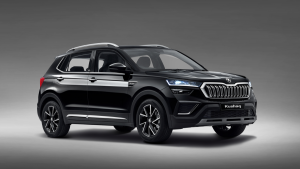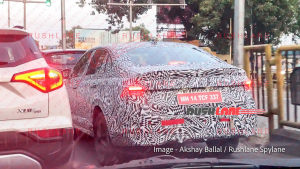Honda City e:HEV hybrid vs Volkswagen Virtus vs Skoda Slavia comparison review
Sedans are dead⦠It's SUVs all the way now⦠You hear this quite a bit these days, right? And, to be fair, it's mostly true. So three new sedans within the space of six months is somewhat of an event for the ones still holding on to their three-boxed guns. Especially ones as varied in their proposition as the Skoda-VW twins, the Skoda Slavia and the Volkswagen Virtus, and the Honda City Hybrid.
Honda City e:HEV hybrid vs Volkswagen Virtus vs Skoda Slavia exterior, dimensions
If you still haven't been tempted into SUVs, you probably want your sedan to make just that right impression on the move. That fine balance projects you to be someone who has made it in life but still likes a good time behind the wheel. The Skoda Slavia and Volkswagen Virtus seem to be better at this on first acquaintance. The two are visibly larger than the City and come with quite some presence even in a sea of SUVs.
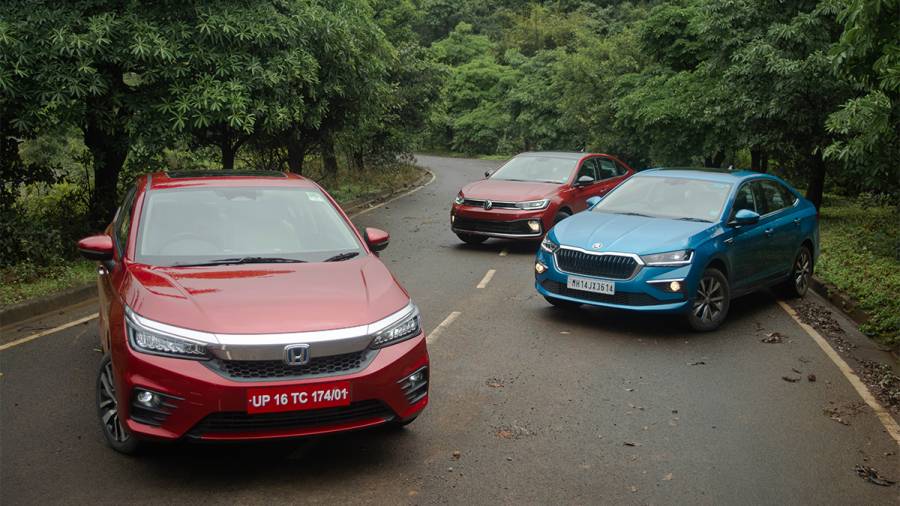
The Skoda takes the more traditional stance with its more bulged bodywork, the more angular lighting and the dashes of chrome. But it's the Volkswagen Virtus that seems more proportionate. The two share quite a few body panels but the Virtus seems to come across as better stanced with its horizontal styling elements, and with the smart use of contrasting black in this GT Line variant. The bodywork is a bit tauter while the blacked-out lighting elements do an effective job of covering for the bulky rear end. Dimensionally, the two are near identical with their 1,752mm height and 1,507mm width. The Volkswagen is 20mm longer at 4,561mm.
That being said, you won't be left wanting with the Honda City. It's only 11mm shorter, 4mm narrower and 18mm lower than the Virtus. The City Hybrid comes with a sportier body kit with the grated bumpers and boot spoiler but this is quite thoughtfully integrated. It doesn't hinder the unfussy look of the car. But it's also not anonymous thanks to those wide LED headlamps and the big chrome slab in front. Like most Honda Citys before, this one should age rather well. As before, we still would like more substantial wheels. But either way, the way they look is far from a deal-breaker for any of these three.
Honda City e:HEV hybrid vs Volkswagen Virtus vs Skoda Slavia interior, features
On the inside, it's fine margins separating these three again. We find the Volkswagen Virtus' cabin to be the most visually appealing with the flat gloss black dash and the quite tasteful use of contrasting colours in this GT variant. The red highlighting looks premium here and it's the same with the seats. The simple rectangular air vents look a bit plain but function with a nice heft and precision.
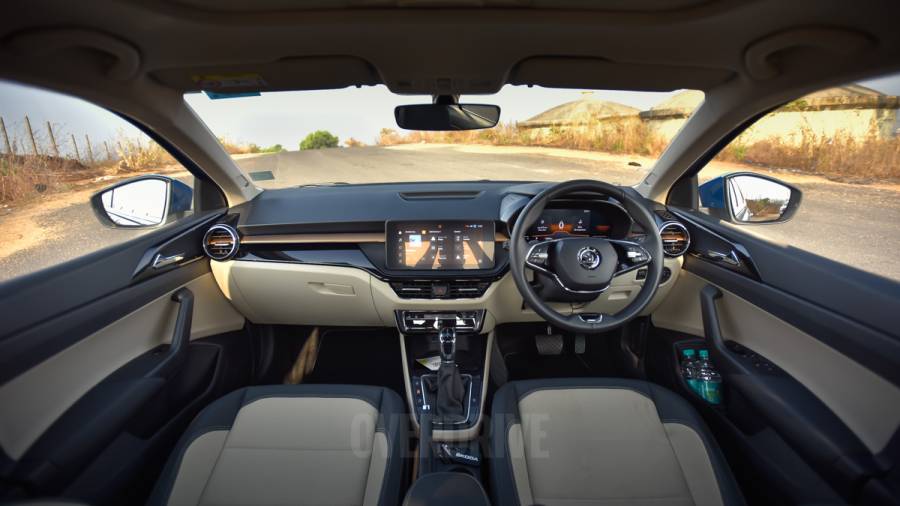
The Skoda Slavia takes a marginally softer approach. There's a bit less gloss black and the layered theme makes the cabin feel a touch airier, especially with the slim bronze band running across. There's some more flair to the design here with the circular air vents and texturing on the doors. Although very similar, we think Volkswagen's placement of the few physical switches that are there in these cars on the driver's side of the gear lever is easier to use. Both get the same door pads with great storage and the same well-judged seats. They also have the crucial ventilated seats, which in these cars are much quieter than the ones in the SUVs that came before. You get that crisp, intuitive 10-inch touchscreen in both.
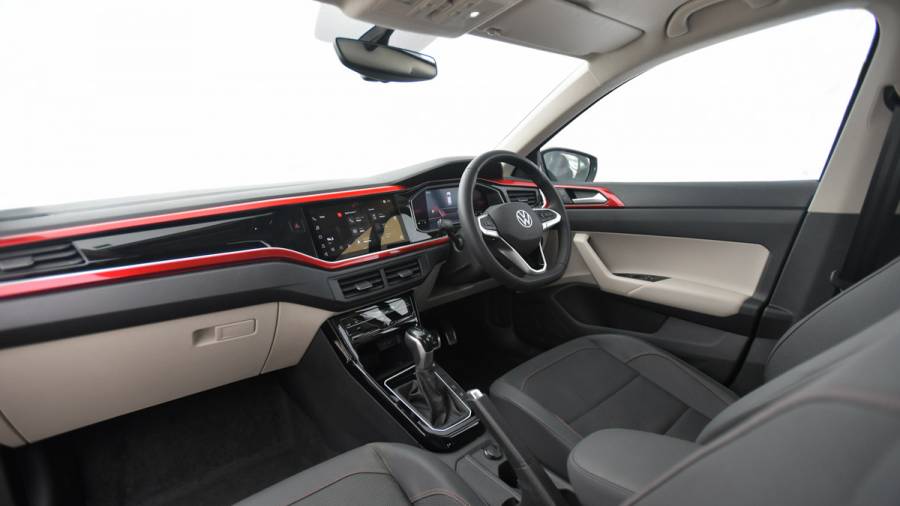
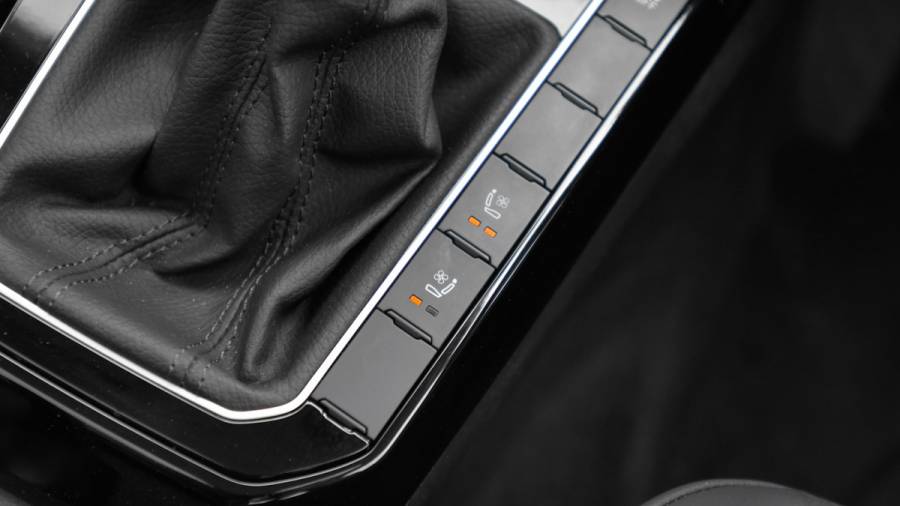
But even the smaller 8-inch one these are being swapped with for now to tide over the supply crunch should be more usable than the grainy, aftermarket-feeling one in the City. The Volkswagen's steering wheel feels marginally easier to use without the plasticky rollers from the Slavia, although both are just the right size and the Slavia's looks nicer with its contrasting free spaces. The digital instrument cluster is the same in both again, with different colour themes, and it does a good job of presenting information legibly although it could do with slightly less convoluted sub-menus. As before, our biggest complaint with both these cars is the touch AC controls. You invariably need to take your eyes off the road to use them and you never seem to hit the button you want to at first try.
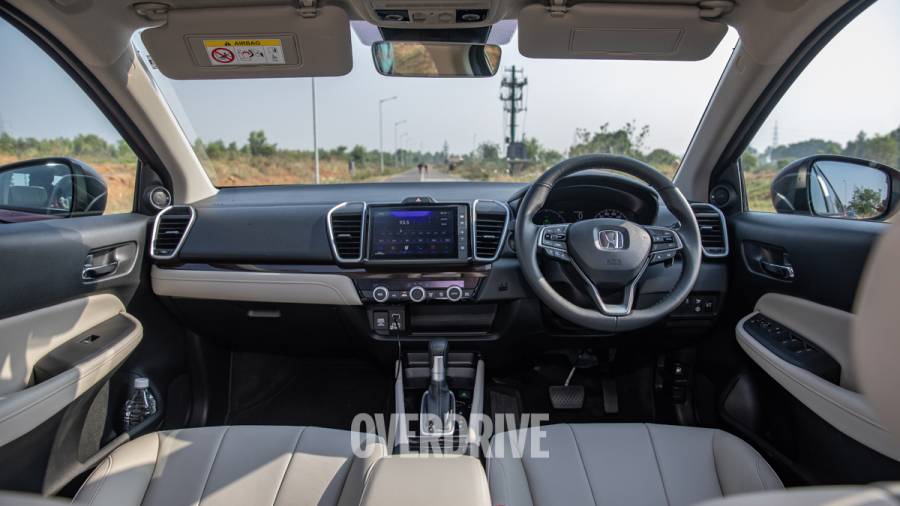
This brings us neatly to the Honda City Hybrid. The Hybrid's cabin is largely identical to the one in the other Citys which means you have what could be the most satisfying climate control knobs this side of a luxury car. The dials function with heft and a satisfying click, and using them becomes second nature very quickly. This soothing sensation transcends through much of the Honda's cabin. The plastics may look a touch grainier than in the Europeans but feel a bit more solid. Similarly, the layout is simpler than in the other two cars here but you find more soft-touch materials like in the horizontal panel in front of the passenger and along the door cards. Even the leather upholstery feels a higher grade, and the discreet wood panelling is well done too.
The City has better feeling switchgear as well with physical controls for most functions. The steering wheel stalks may feel a bit less substantial than the Slaiva or Virtus but the buttons and rollers on the steering again function with tactility and precision. The digital instrumentation may still use an analogue speedo but displays information more cleanly.
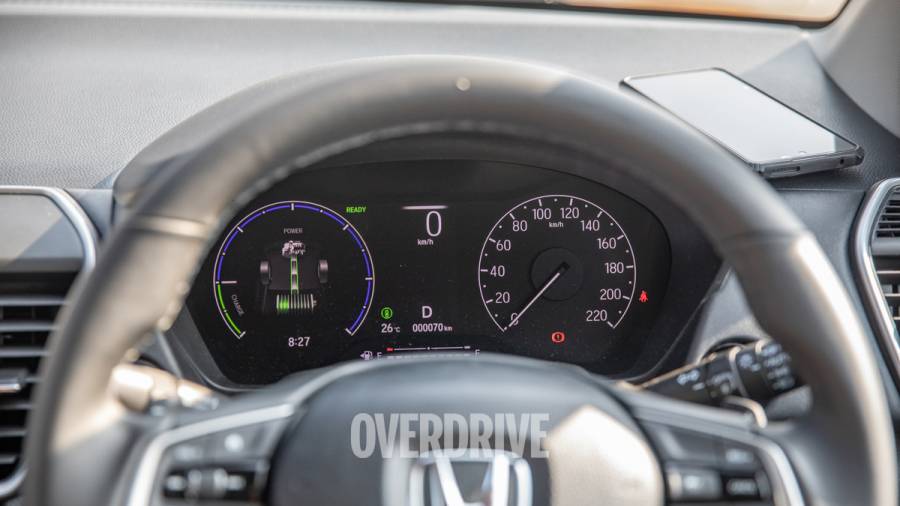
The centre console too has more storage space and while the front footwell may be tighter than the Slavia or Virtus you have better elbowroom. But the seats themselves aren't as supportive with too much lower back bolstering. Finding the right driving position is not as straightforward as in the other cars here.
The Skoda Slavia and the Volkswagen Virtus have a 51mm wheelbase advantage over the Honda City hybrid. But the differences in the rear seat are more nuanced than that. The City is the better car for three with its wider bench and you also get a retractable rear shade. But the seatback is again too heavily bolstered for the lower back and the bench has a curved edge that compromises under-thigh support marginally from the other two.
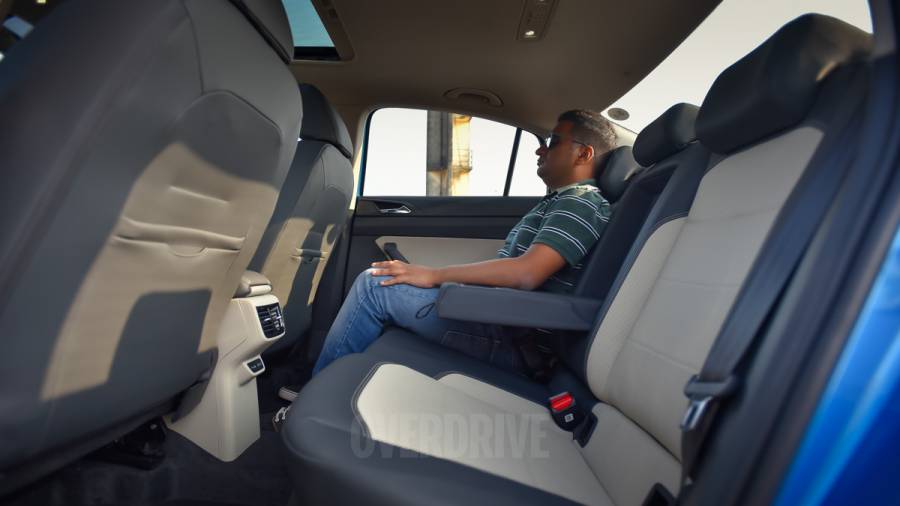
The Slavia and Virtus have a more upright rear seat but the seats are thoughtfully contoured. This will make the third passenger unhappy but the bench is flatter and there is better legroom thanks to the higher-placed front seats. There's little to choose between the cars here in terms of knee room but the Honda has an upward slope to the floor which some may or may not like. The twins give you Type-C charge ports here, more modern than the two 12V outlets in the City. Between the Sliva and Virtus, there's really no difference other than the Skoda feeling a touch more spacious with its beige-heavy colour pattern on the seats.
Honda City e:HEV hybrid vs Volkswagen Virtus vs Skoda Slavia driving impressions
The Skoda Slavia and Volkswagen Virtus twins, quite expectedly, offer up quite a different driving experience from the hybrid Honda City. The Honda City uses the complex e:HEV hybrid powertrain but to Honda's credit, you are largely immune to these intricacies on the move. In heavy city traffic, the City Hybrid has enough juice in its small 0.7 kWh battery to make for an easy driving experience. The City hybrid usually starts on battery power alone before the engine cuts in quickly enough. So while this intervention is quite harsh it still means that the City has brisk responses off the line.
And as speeds rise, the engine becomes effectively a range extender up until highway speeds. This feels somewhat unnatural considering the engine is at a constant rpm to be most efficient but you are still gaining speed. It is a complex system but is easily explained through the instrumentation graphics. Practically you have a fair amount of performance if you are looking at a largely urban runabout. The City is not that far behind the other too in all-out acceleration. But the hybrid Honda is still no brisk turbo-petrol with beefy mid-range torque. So overtakes do take a bit more patience considering the combined outputs of the e:HEV system at 126PS are still lower than the 1.5-turbo-DCT combination in the Skoda Slavia and VW Virtus with their 150PS and 250 Nm. Of course, the advantage here is the exceptional fuel efficiency. We've seen up to 19 kmpl in the Honda City in heavy traffic where electric power does most of the heavy lifting, but you can expect the roughly 17 kmpl we got on this test in freer traffic. And once you've got the hang of the paddle-operated regen modes this should only improve. They function exactly like in a BEV and the highest of which will bring you right down to crawling speed, no full one-pedal driving, the City is a low-effort city car.
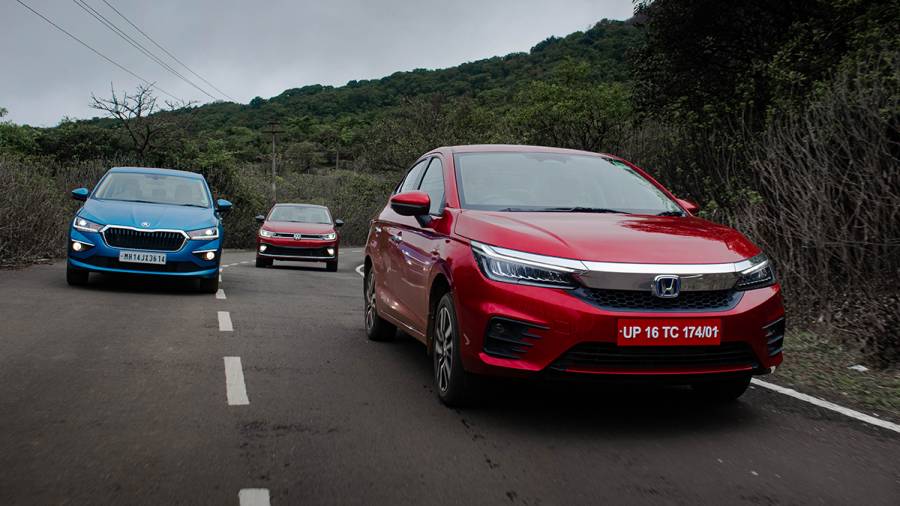
As for the Slavia and Virtus, they can't quite match those efficiency numbers. But most of the lower speed foibles of these VW Group DCTs have been filtered out. So with both these sedans, it's an energetic driving experience right from the get do. The DCT is more conservatively tuned than say in the Octavia so the uninterrupted motion of the City is missing here. The gearbox usually needs to shift down a few gears when you want a burst of performance. But shifts as always are crisp and both these cars don't feel out of place in city traffic. The steering is also lighter in the Europeans, but no less direct than the one in the City. The added weight in the Honda makes tight manoeuvres just a bit more cumbersome.
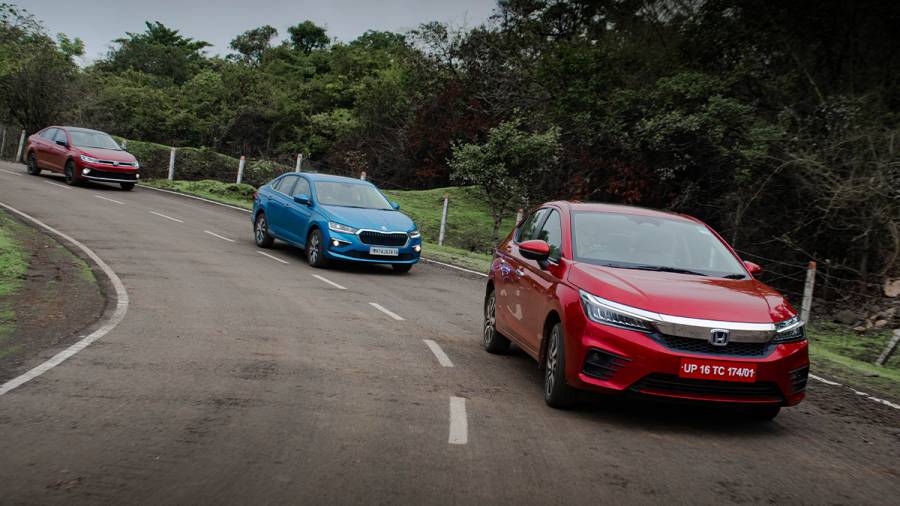
But as highway machines, the margins between the turbo-petrols and the City hybrid narrow. The Skoda and Volkswagen have a more refined, and quieter engine. It helps make them calmer on a highway cruise and there's less wind and tyre noise too here. The City isn't too far behind on these counts but is more softly sprung than the Skoda and VW and handles our typical sharp, low-speed imperfections better. The trade-off is a bit more body roll around bends and some pitching and diving. It's still a fairly taut drive but the City Hybrid can't quite match the poise and confidence the Slavia and Virtus offer, especially for those of you who take pleasure in driving. And with the well-calibrated cylinder deactivation tech, these two are also not that far behind on highway efficiency. The Virtus was right on par with the City with its 18.2 kmpl vs the Honda's 18.6. The Slavia is a little way behind at 16.5 kmpl.
Honda City e:HEV hybrid vs Volkswagen Virtus vs Skoda Slavia safety
The Honda City has a clear advantage in this regard. It's the only one here to get a full suite of ADAS features. The system itself isn't the most intuitive for Indian conditions but just having that safety net is a significant reassurance. The Honda is also the only one here with rear disc brakes and feels the most confident during panic braking. The Slavia here didn't seem to be best with its brakes, needing quite a bit of travel before taking effect, but we don't remember it feeling this way from our tome with it earlier. This hasn't affected stopping distances and both the Skoda and VW have competent braking performance in isolation. All three also get six airbags and the usual crop of passive safety features.
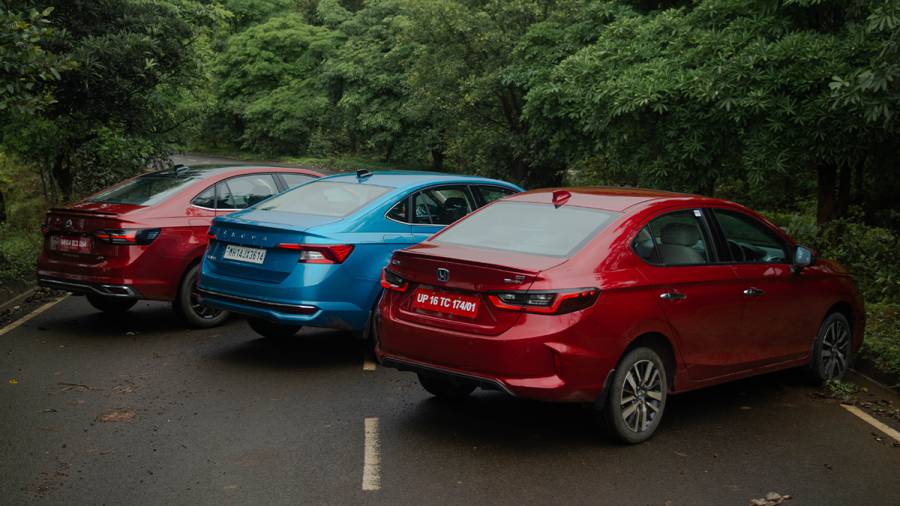
Honda City e:HEV hybrid vs Volkswagen Virtus vs Skoda Slavia prices, verdict.
All things considered, it's the Honda City Hybrid that edges out the other two to be our pick. At rs 22.9 lakh on-road, it is Rs 1.3 lakh more than the Skoda Slavia and Rs 1.6 lakh more than the Volkswagen Virtus. For that premium, you get the obvious benefits of a hybrid powertrain, an interior that feels plusher in places and performance that's not that far behind the Europeans. But if you want a sedan for the driving chops, the Slavia and Virtus have you covered. They are easily the most fun you can have for this money in the country now, are quite efficient themselves and feel larger inside. A close one that makes us wonder if we really should be falling out of favour with our three-boxed cars.
Honda City e:HEV hybrid vs Volkswagen Virtus vs Skoda Slavia specifications, real-world mileage, performance
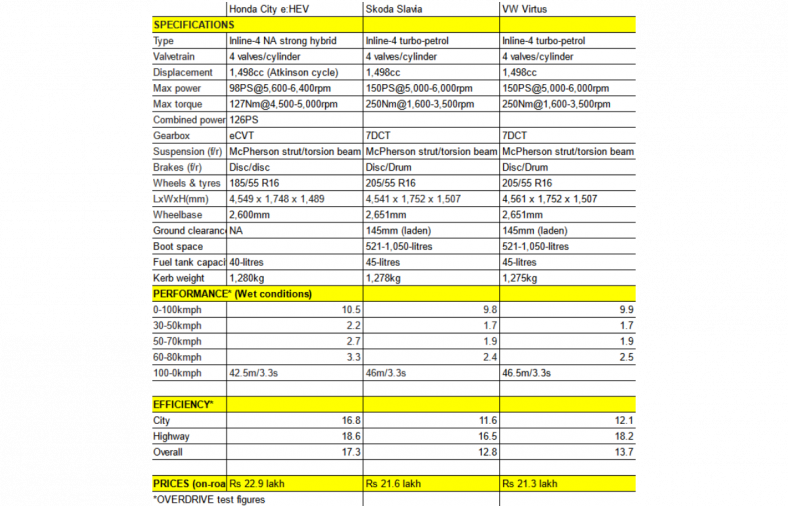
Text: @tuhinguha
Images: @arppithaandaa
Also read,
2022 Honda City hybrid e:HEV review, first drive â" real-world mileage tested
2022 Honda City eHEV: Unique hybrid system explained
2022 Volkswagen Virtus 1.5-litre GT review, first drive â" good news for enthusiasts?
2022 Volkswagen Virtus 1.0-litre AT review, first drive - the sweet spot?
2022 Skoda Slavia 1.5-litre first drive review
2022 Skoda Slavia 1.0-litre first drive review
Starts Rs 10.9 Lakhs
1497cc
Manual
100
145
17.8 Kmpl
Starts Rs 10.69 Lakhs
1498cc
Automatic
150
250
18.41 Kmpl
Starts Rs 11.22 Lakhs
999cc
Manual
115
178
18.12 Kmpl
Starts Rs 19.5 Lakhs
1498cc
e-CVT
126
253
26.5 Kmpl
